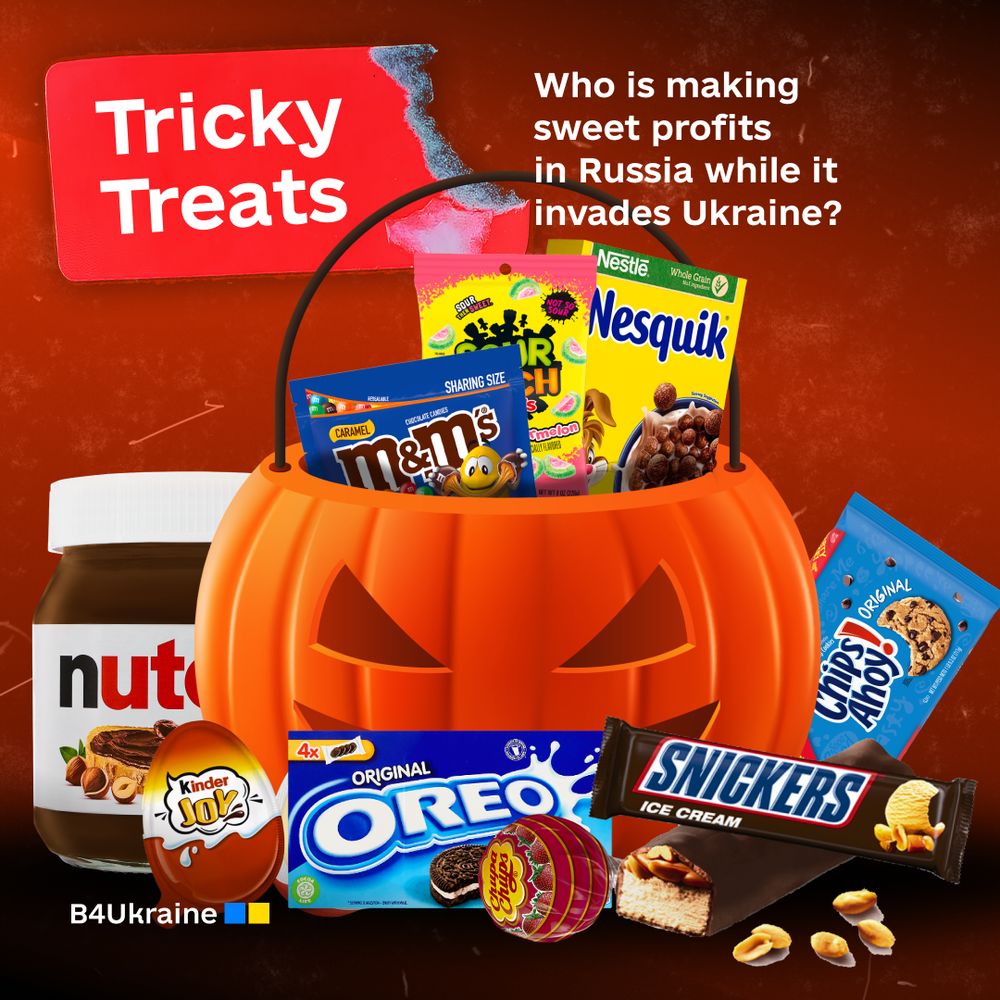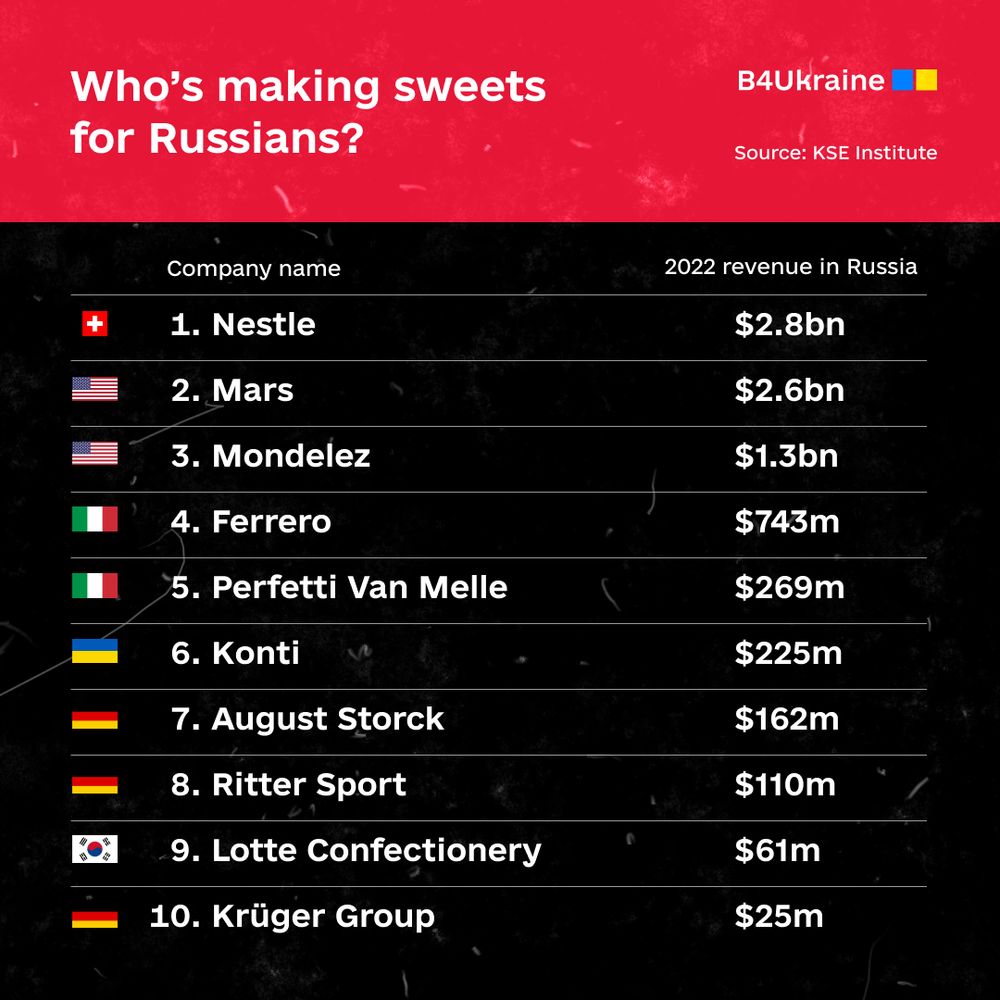
A Halloween candy may seem harmless until you consider that millions of your favorite sweets being sold in Russia daily can help to fund real-life horrors
Halloween is coming, the most beloved holiday of millions of children and confectionaries that generate billions in profits annually. Only Americans are expected to spend $3.6 billion on sweets for the holiday. Sadly, this year, the trick-or-treat bag will remain empty for at least 20,000 Ukrainian children who were either brutally murdered or forcefully deported to Russia. But large candy makers can be proud of themselves and celebrate: their profits in the aggressor state waging a genocidal war against its peaceful neighbor are really impressive!
It’s been 20 months since Russia launched an all-out war against Ukraine. While some well-known confectionary goods producers such as Lindt, Haribo, Fazer and Marks & Spencer have all left the Russian market, other big names like Mars, Ferrero, Mondelez, and Nestlé have chosen to continue doing business in and with Russia, paying taxes to the regime and indirectly helping to fund the war. All four claim to have scaled back activity in the aggressor state. Yet, they were still all among the largest revenue earners in the country last year.
Working in Russia, all companies must comply with a new law obliging them to contribute directly to the war effort, potentially through the conscription of their workforce or supplying other resources to the Russian army. Yet calls to exit were rebuffed by the ‘sticky’ firms. Many argue they are providing essential, everyday goods to the Russian market. Clearly not buying this argument, the Ukrainian government placed Mondelez and Mars on its blacklist as an ‘international sponsor of war.’
So, who is sweetening the lives of Russians?
10. Krüger Group, Germany: Ludwig Schokolade, Schogetten, Trumpf, Mauxion, FRITT
Krüger, one of the leading manufacturers of sweets and chocolates worldwide, increased its market share of chocolate in Russia after the Ukraine invasion, according to the Kyiv School of Economics.
9. Lotte Confectionery, South Korea: Choco Pie, Perero, Ghana
Lotte Confectionery invested more than $2 billion in a Russian subsidiary before the invasion. “Currently, we are operating our plants, but keeping a close eye on possible additional sanctions that could be imposed,” the company’s official said in March 2022.
8. Ritter Sport, Germany
Ritter Sport stopped investments and advertising in Russia, but publicly committed to remain in the country citing its concern for employees and suppliers: “to secure jobs and the livelihoods of many cocoa farming families we continue to supply chocolate to the Russian population.” While this mid-sized German firm’s concern for farmers is commendable, does it justify a year-to-year 91% increase in exports of its products to Russia? It is certainly not easy to leave a country that generates close to 10% of your global revenue, but it should and can be done.
7. August Storck, Germany: Werthers Originals, Toffifee, Merci, Nimm 2, Dickmanns, Riesen, Knoppers, Mamba
In terms of sales, Storck — or August Storck KG — is one of the largest confectionery manufacturers in the world. Storck products certainly bring joy. However, they are not necessary for survival. It is therefore somewhat questionable why the Berlin-based company is simply allowing its Russian business to continue despite Moscow’s crimes against humanity.
6. Konti, Ukraine: Kontik, Mousse, Jack, Belissimo, Bis Konti
Konti is one of the largest manufacturers of confectionery products in Ukraine. The company is associated with Boris Kolesnikov, a pro-Russian politician, and minister in the government of runaway president Viktor Yanukovych. The firm continued to operate in Russia and increased capacity, having acquired an additional factory shortly before the invasion, according to KSE. Kolesnikov denied any involvement in the acquisition.
5. Perfetti Van Melle, Italy/Netherlands: Airheads, Chupa Chups, Chocoliebe, Mentos
In March 2022, the company described the “situation in Ukraine” as “aggression” and committed to donating to Ukraine’s humanitarian relief, yet decided to stay in the aggressor state: “We have stopped all new investments, all promotional and advertising activities. At the moment only basic activities continue to maintain the employment of our 1,500 colleagues.”
4. Ferrero, Italy: Nutella, Ferrero Rocher, Raffaello, Kinder, Tic Tac
Ferrero too announced it would be downscaling all non-essential operations, such as advertisement and promotions. The company claims that it is only providing essential food products in Russia. Yet its export of chocolates to Russia increased by 33% in the year after the invasion.
3. Mondelez International, USA: Oreo, Sour Patch Kids, Ahoy Chips, Toblerone, Cadbury
According to Ukraine’s government, the US snacking giant increased its profit in Russia last year. Mondelez claims that cookies and chocolates it sells in the country are part of a “normal diet,” implying the essentiality of its products and citing it as a reason to stay. The company’s CEO Dirk van de Put has also cited the company’s support for over 30,000 local farmers in Russia as a reason to remain. However, customs data show an increase in Mondelez’s imports of its products from third countries into Russia. Instead of producing its signature Milka chocolates locally, Mondelez’s imports of Milka rose 131% between April 2022 and March 2023. Mondelez has not committed to leaving Russia. It issued a statement on June 15th announcing its intention to make its business in Russia “stand-alone with a self-sufficient supply chain by the end of this year.” This is not the same as exiting Russia.
2. Mars, USA: Snickers, Starburst, Skittles, M&M’s, Twix, Bounty
Mars said that it had scaled back some parts of its business in Russia and would refocus “efforts in Russia on our essential role in feeding the Russian people and pets.” However, Mars’ factories continue to operate in Russia with increased revenues in 2022 compared to 2021, the Ukrainian government stated.
1. Nestle, Switzerland: Nesquik, Nuts, Aero, After Eights, Smarties, Rolo
The world’s largest fast-moving consumer goods company pledged to sell only “essential” goods in Russia, such as infant food and medical/hospital nutrition, but the reality is that over 50 Nestle products such as Nescafe, Maggi soups, Bystrow cereals, Purina pet food, Nestea, chocolates and sweets are still reportedly available in Russia. Likewise, Mövenpick ice cream is reportedly still available under a new name (Monterra), and so is imported Perrier water.
Combined, the top ten revenue-generating confectionaries paid around $200 million in profit tax to the Kremlin in 2022. With that money, Russia could have obtained 66 Iskander missiles or other weapons that have been used against Ukrainian civilians. On October 5th, the Iskander missile struck a cafe in the village of Hroza, in Ukraine’s Kharkiv region, killing 52 people who gathered to commemorate a fallen soldier. Russia’s UN envoy said they were Nazis and had to die. As a result of the strike, six children were left orphaned.
